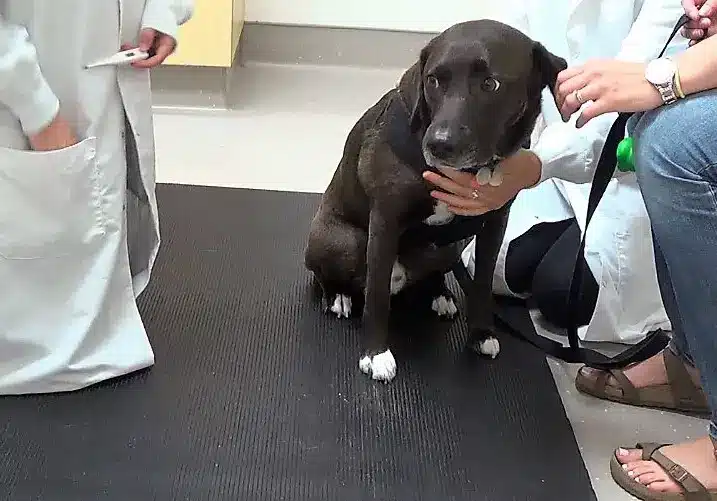behavior modification, Counter-conditioning, Desensitization, dog anxiety, dog fears, dog phobias, veterinary visits
Help For Fear of Veterinary Visits
Help For Fear of Veterinary Visits
By Will Bangura, M.S., CBCC-KA, CPDT-KA, (Dog Behaviorist), Certified Dog Behavior Consultant
Fear of veterinary visits is a common issue in dogs and can cause significant stress and anxiety for both the pet and its owner. The fear may stem from previous painful experiences, unfamiliar surroundings, or unfamiliar handling during previous visits. Desensitization and counter-conditioning are two evidence-based techniques used to modify the dog’s emotional response to the feared stimulus (veterinarian visits in this case). This article provides a step-by-step guide on using these techniques to help dogs overcome their fear of veterinary visits.
Assessment of a dog’s fear of veterinary visits.
Assess the Dog’s Fear Level Before starting the desensitization and counter-conditioning process; it is important to assess the dog’s level of fear. This can be done by observing the dog’s body language and behavior when presented with the feared stimulus (veterinarian visit) or a similar situation. Common signs of fear in dogs include panting, shaking, hiding, growling, or attempting to escape.
Goal setting for dogs with a fear of veterinary visits.
Set Realistic Goals and Plan a Gradual Approach The goal of desensitization and counter-conditioning is to modify the dog’s emotional response to the feared stimulus by replacing fear with positive emotion. This process should be gradual, starting with low-level stimuli and gradually increasing the difficulty as the dog becomes more comfortable. A gradual approach will prevent the dog from becoming overwhelmed, which could make the fear worse.
Counter-Conditioning to help treat dogs with veterinary visit fears.
Start with Counter-Conditioning. Counter-conditioning is the process of changing the dog’s emotional response to a feared stimulus by pairing it with something positive, such as treats or toys. This positive association can help the dog overcome their fear and view the feared stimulus (veterinarian visit) as a positive experience.
A common counter-conditioning technique is to use high-value treats or toys when the dog is in the presence of the feared stimulus, gradually increasing the duration and proximity of the exposure. For example, suppose the dog is afraid of the veterinarian’s office. In that case, the trainer could start by exposing the dog to a photo or video of the office, gradually moving closer and closer to the actual location over time while rewarding the dog with treats or toys.
Desensitization for dogs with a fear of going to the vet.
Add Desensitization Techniques. Desensitization is the process of gradually exposing the dog to the feared stimulus, starting with low-level stimuli and gradually increasing the difficulty as the dog becomes more comfortable. This process helps the dog get used to the feared stimulus, reducing their fear and anxiety.
When desensitizing a dog with a fear of veterinary visits, start with low-stress procedures, such as touching the dog’s paw or holding the collar, before moving on to more invasive procedures, such as injections or blood draws. The pet owner should work with the veterinarian to create a step-by-step plan for desensitization.
Positive reinforcement training for dogs with a fear of veterinary visits.
Use Positive Reinforcement, such as clicker training. Positive reinforcement is the process of rewarding the dog for desired behavior. In this case, the desired behavior is for the dog to be calm and relaxed during the veterinary visit. The trainer should reward the dog with treats or toys for calming behavior during each exposure to the feared stimulus.
Step 6: Gradually Increase the Difficulty As the dog becomes more comfortable with the exposure to the feared stimulus, the difficulty can be gradually increased. This can be done by increasing the duration of exposure, moving closer to the feared stimulus, or adding more challenging stimuli. The goal is gradually to increase the difficulty to the point where the dog can tolerate a full veterinary visit without exhibiting fear or anxiety.
Desensitization and counter-conditioning are effective techniques for modifying a dog’s emotional response to a feared stimulus, such as a veterinary visit. However, it is important to approach this process gradually and carefully, starting with low-level stimuli and gradually increasing the difficulty as the dog becomes more comfortable.
By combining counter-conditioning techniques, such as pairing the feared stimulus with positive experiences like treats and toys, with desensitization techniques, such as gradually increasing exposure to the feared stimulus, dog trainers can help dogs overcome their fear of veterinary visits. Positive reinforcement, such as rewarding calm behavior during exposures, can also help reinforce the desired behavior and increase the chances of success.
It is also important to note that each dog is unique and may respond differently to desensitization and counter-conditioning techniques. Some dogs may require additional support, such as medication or additional training. It is always best to work with a professional dog trainer, certified dog behavior consultant, dog behaviorist, or veterinary behaviorist to tailor the approach to the individual dog’s needs.
References:
- “Behavior Adjustment Training: BAT for Fear, Frustration, and Aggression in Dogs” by Grisha Stewart
- “Canine Behavior: A Photo Illustrated Handbook” by Barbara Handelman
- “The Culture Clash” by Jean Donaldson
- “Low-Stress Handling, Restraint and Behavior Modification of Dogs & Cats” by Sophia Yin, DVM, MS
- “Treat Your Dog: Understanding and Changing Behavior” by R.K. Anderson.
- Fear Free Certified Veterinary Practice Directory https://fearfreepets.com/certified-practice-directory
In conclusion, with patience and consistency, dog owners can use desensitization and counter-conditioning techniques to help dogs overcome their fear of veterinary visits and create a positive association with the experience. The ultimate goal is to help the dog feel calm and relaxed during veterinary visits, reducing stress and anxiety for both the pet and their owner.


